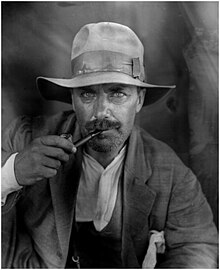William Moir Calder
William Moir Calder | |
|---|---|
 Calder, probably in 1924 or 1925 | |
| Born | 2 July 1881 Edinkillie,Moray,Scotland |
| Died | 17 August 1960(aged 79) Elgin,Moray |
| Academic background | |
| Education | |
| Academic work | |
| Institutions | |
| Military career | |
| Allegiance | United Kingdom |
| Service/ | Admiralty |
| Wars | First World War |
Sir William Moir CalderFBAFSAS(2 July 1881 – 17 August 1960) was a Scottish archaeologist,epigraphist,classicist, and academic. He was Hulme Professor of Greek at theUniversity of Manchesterfrom 1913 to 1930, and Professor of Greek at theUniversity of Edinburghfrom 1930 to 1951.
Education
[edit]Calder was born on 2 July 1881[1]at Edinkillie inMoray.[2]His father, George MacBeth Calder, was a farmer.[3]The younger Calder attended theUniversity of Aberdeen,graduating in 1903 with a first-classMaster of Arts(MA) degree in classics;[4]later that year, he secured the Ferguson Scholarship for classics[5]and went up toChrist Church, Oxford.[2]In 1904, he won theGaisford Prizeand the following year was awarded the Craven Scholarship.[6]In 1907, he graduated with a second-class Bachelor of Arts degree inLiterae humaniores.[4]
Career
[edit]Calder was elected to the Craven Fellowship for 1907–08. For four years from 1908 to 1912, he was then the Hulme Research Student atBrasenose College, Oxford,[6]and travelled toParis,Berlin,Rome,GreeceandTurkey;he extensively exploredLycaonia,PhrygiaandGalatiawhere he collected a range of materials for future study, worked with the archaeologists SirWilliam Mitchell RamsayandGertrude Bell,and developed an interest in thePhrygian languageand the early spread ofChristianityin those regions.
In 1913, he was appointed Hulme Professor of Greek at theUniversity of Manchester,but he served in theAdmiraltyduring theFirst World War,and theGreco-Turkish Warof 1919 to 1922 then prevented Calder from returning toAsia Minoruntil the conflict's cessation.[2]
Calder's return to Asia Minor coincided with Ramsay's retirement, and he became a leading archaeologist in the area in collaboration with W. H. Buckler and the American Society for Archaeological Research in Asia Minor.[2]In 1923, he and Buckler co-editedAnatolian Studies Presented to Sir William Mitchell Ramsay(published byManchester University Press).[6]and during 1924–25, they carried out archaeological excavations in Asia Minor which lead to the publication ofMonumenta Asiæ Minoris Antiqua(MAMA). Calder was responsible for the first, fourth, sixth and seventh volumes which appeared between 1928 and 1956. The work's innovative use of photographs alongside every recorded inscription proved influential and, while Buckler was mostly responsible for the organisation and deciphering of these inscriptions, Calder carried out most of the field work and wrote extensive commentaries in various academic journals alongside theMAMApublication. In the meantime, Calder had been appointed Professor of Greek at theUniversity of Edinburghin 1930 and it was only after his retirement in 1951 that he was able to finish theMAMAand return to Turkey for two further trips.[2]
Calder served as president of theSociety of Antiquaries of Scotlandin 1950 and of theClassical Associationin 1951, and as editor of theClassical Reviewfrom 1923 to 1935. He wasknightedin 1955, elected aFellow of the British Academyin 1931, and elected to anhonorary fellowshipat Brasenose College in 1956. He died on 17 August 1960,[6]inElgin.[3]
Likenesses
[edit]- Sir William Moir Calder,byElliott & Fry(bromide print, 1955). Kept in theNational Portrait Gallery, London(Photographs Collection, NPG x86595).
References
[edit]- ^"Sir William Calder",The Times(London), 19 August 1960, p. 12.
- ^abcde"Sir William Calder 1881–1960",Anatolian Studies,vol. 11 (1961), pp. 29–37.
- ^ab"Records of the American Society for Archaeological Research in Asia Minor".JISC Archives Hub. Archived fromthe originalon 3 October 2023.Retrieved31 May2024.
- ^abUniversity of Edinburgh Journal(1960), p. 79.
- ^"The Ferguson Scholarships",The Scotsman,1 October 1903, p. 4.
- ^abcd"Calder, Sir William Moir".Who Was Who (online ed.).Oxford University Press. December 2007.Retrieved30 August2019.
- 1881 births
- 1960 deaths
- Scottish classical scholars
- Alumni of the University of Aberdeen
- Alumni of Christ Church, Oxford
- Alumni of Brasenose College, Oxford
- Academics of the University of Manchester
- Academics of the University of Edinburgh
- Knights Bachelor
- Fellows of the British Academy
- Fellows of the Society of Antiquaries of Scotland
